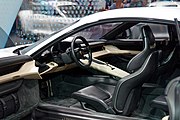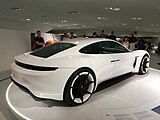Porsche Taycan
| Porsche | |
|---|---|
|
Porsche Taycan Turbo at the IAA 2019
|
|
| Taycan | |
| Sales designation: | Taycan |
| Production period: | since 2019 |
| Class : | Upper class |
| Body versions : | limousine |
| Engines: | Synchronous machines: 460-560 kW |
| Length: | 4967 mm |
| Width: | 1966-2144 mm |
| Height: | 1378 mm |
| Wheelbase : | 2900 mm |
| Empty weight : | 2370-2380 kg |
| Stars in the Euro-NCAP - crash test (2019) |
|



The Porsche Taycan is a battery-electric sports car from the automobile manufacturer Porsche . It was presented to the public on September 4, 2019 and initially offered in the Turbo and Turbo S versions. The four-door coupé is half a class below the Porsche Panamera in the Porsche portfolio .
history
On December 4, 2015, Porsche announced that a series vehicle would be created based on the Mission E concept study .
In addition to the fully electric drive, the outstanding development goal is for the car to be able to drive autonomously for a long time without the driver's attention ( level 4). According to Porsche CEO Oliver Blume , you should be able to drive the car yourself at any time.
In Norway, the vehicle can be reserved since mid-April 2018 for a deposit of 20,000 Norwegian kroner (around € 2,000).
On June 8, 2018, Porsche announced that the production model would be called Porsche Taycan.
On September 4, 2019, the Taycan Turbo models with a maximum engine power of 500 kW and the Taycan Turbo S with a maximum engine power of 560 kW were presented to the public.
The Taycan is to be launched in Japan in 2020 . ABB announced on April 12, 2019 that it would start operating a fast charging network in Japan from mid-2020.
The first Turbo S were delivered in the USA at the end of December 2019.
Surname
There were 600 ideas for the vehicle name, from which marketing experts finally chose “Taycan” as a favorite. Two native speakers of each of these languages were consulted for over 20 languages in order to rule out any negative associations with possible model names. The name is systematically developed: the ay is known from Cayenne and Cayman , the can from the Macan . The word comes from Turkish and means "soul of a lively foal" ( tay = foal; can = soul). This derivation fits in with the advertising slogan soul, electrified. The word pronounced "Taican" means roughly "physical experience" in Japanese.
technology
The Porsche Taycan has four doors and is driven by two synchronous motors with a system voltage of 800 volts . The maximum total output is 500 kW (680 PS) or 560 kW (760 PS). The Taycan Turbo S accelerates from 0 to 100 km / h in 2.8 seconds.
The Taycan's drive battery has a usable capacity of 83.7 kWh (93.4 kWh gross) and is embedded between the axles in the vehicle floor. The lithium-ion cells come from the Korean manufacturer LG Chem and are pre-assembled into battery modules by the German Dräxlmaier group . In order to improve the sitting position on the back seat, no battery modules were installed in the footwell of the second row of seats, creating indentations called foot garages . The Porsche Taycan has four seats; a 4 + 1 seat configuration is available at an additional cost.
The dashboard has a curved, digitally controlled display behind the steering wheel and two other displays in the middle. An additional display on the passenger side is available at an additional cost.
Technical specifications
| model | 4S | turbo | Turbo S | |
|---|---|---|---|---|
| Construction period | since 12/2019 | |||
| battery | Performance battery | Performance battery plus | ||
| Battery capacity | 71 kWh (net), 79.2 kWh (gross) | 83.7 kWh (net), 93.4 kWh (gross) | ||
| Motor type | Front and rear: permanent magnet synchronous machine | |||
| Drive type | all wheel drive | |||
| Range (according to WLTP ) | 333-407 km | 386-463 km | 381-450 km | 388-412 km |
| Long Range Range (1) | 320 km | 365 km | 370 km | 370 km |
| Range (according to EPA ) | 322 km | 309 km | ||
| Engine output kW (PS) with Launch Control |
390 (530) | 420 (571) | 500 (680) | 560 (761) |
| Continuous output kW (PS) | 320 (435) | 360 (490) | 460 (626) | |
| Max. Torque at launch control |
640 Nm | 650 Nm | 850 Nm | 1,050 Nm |
| cW | 0.22 | 0.25 | ||
| Consumption NEDC | 24.6 kWh / 100 km | 25.6 kWh / 100 km | 26.0 kWh / 100 km | 26.9 kWh / 100 km |
| Consumption EPA | 30.6 kWh / 100 km (49.0 kWh / 100 mi) | 31.3 kWh / 100 km (50 kWh / 100 mi) | ||
| Acceleration 0-100 km / h | 4.0 s | 3.2 s | 2.8 s | |
| Acceleration 0–200 km / h | 13.3 s | 12.9 s | 10.6 s | 9.6 s |
| Max. speed | 250 km / h | 260 km / h | ||
| Empty weight according to EG | 2215 kg | 2295 kg | 2380 kg | 2370 kg |
| Dimensions L × W × H: | 4963 × 1966 × 1379 mm | 4963 × 1966 × 1381 mm | 4963 × 1966 × 1378 mm | |
| Turning circle | 11.7 m front- wheel steering (standard) 11.2 m all-wheel steering (option) |
11.2 m all-wheel steering (standard) | ||
| (1) Orientation value, determined according to the WLTP test cycle (special equipment is taken into account for weight, aerodynamics and on-board power supply requirements (idle current), no working air conditioning system.) | ||||
Sales figures
production
A total of 1,386 Porsche Taycan were produced in 2019.
Registration numbers
In the first sales year 2019, 31 Taycans were newly registered in the Federal Republic of Germany. 819 vehicles were delivered worldwide.
| year | piece | |||
| 2019 | 31 | |||
| 2020 to July | 1,426 | |||
| Registration figures in Germany, source: Federal Motor Transport Authority | ||||
Mission E concept vehicle
| Porsche | |
|---|---|

Porsche Mission E concept vehicle at the IAA 2015 |
|
| Mission E concept study | |
| Presentation year: | 2015 |
| Vehicle fair: | IAA |
| Class : | Upper class |
| Body shape : | Station wagon |
| Length: | 4850 mm |
| Width: | 1990 mm |
| Height: | 1300 mm |
| Production model: | since 2019 |
The Porsche Mission E concept vehicle was presented at the 2015 IAA in Frankfurt am Main .
The vehicle is driven by two synchronous motors with a system voltage of 800 volts . The total output of the system is up to 500 kW (680 PS) and accelerates the car from 0 to 100 km / h in less than 3.5 s and to 200 km / h in less than 12 s, the top speed is more than 250 km / h specified. A pre-production Taycan achieved a lap time of 7:42 minutes on the Nordschleife of the Nürburgring , which is a new best time for four-seater, all-electric sports cars.
The range ( NEDC ) given when the battery is fully charged is 500 km with a battery capacity of at least 100 kWh. Per IONITY - charging station charging are possible according to the manufacturer within less than 15 minutes 80%.
No exterior mirrors are mounted on the concept vehicle; Cameras transmit important images of the surroundings in the lower right and left areas of the inside of the windscreen. Furthermore, the concept study has round instruments with eye-tracking function and is designed for gesture control so that the driver can e.g. B. can change the temperature with a wave of the hand.
The concept vehicle with the portal doors open
Front wheel with central locking
literature
- Frank Kreif: Electric car with turbo? The new Porsche Taycan. (Cover story) In: Electric Drive , No. 3/2019, pp. 40–43.
Web links
Individual evidence
- ↑ Official Porsche Taycan safety rating. In: euroncap.com. Retrieved December 4, 2019 .
- ↑ Spiegel Online: Porsche Taycan electric sports car , accessed on June 7, 2019
- ↑ Auto-Motor-Sport: Electric athletes go into series production. From: www.auto-motor-und-sport.de , February 9, 2016, accessed on February 15, 2016 .
- ↑ autocar.co.uk, October 19, 2017: Porsche Mission E to get advanced autonomous technology and active aerodynamics , accessed February 22, 2018
- ↑ electrive.net, April 17, 2018: Porsche Mission E can now be reserved in Norway , accessed May 2, 2018
- ↑ Mission E becomes Taycan. In: Porsche Newsroom. Retrieved June 8, 2018 .
- ↑ Herbie Schmidt: Porsche launches first electric car. In: nzz.ch . September 4, 2019, accessed September 4, 2019 .
- ↑ ABB gives Porsche start-up assistance with electric cars. In: watson.ch . April 12, 2019, accessed April 12, 2019 .
- ↑ Porsche delivers first electric car to US customers. In: ecomento.de. December 23, 2019, accessed December 24, 2019 .
- ↑ Taycan: The Porsche with the Turkish name. Retrieved June 12, 2019 .
- ↑ The genesis of the name "Taycan". Retrieved September 23, 2019 .
- ↑ Porsche is apparently planning a battery cell factory with custom cells on electrive.net, accessed on August 12, 2020.
- ↑ a b 2020 Porsche Taycan Turbo. Retrieved December 12, 2019 .
- ↑ a b 2020 Porsche Taycan Turbo S. Retrieved January 15, 2020 .
- ↑ Porsche Car Configurator. Retrieved August 19, 2020 .
- ↑ WLTP - worldwide at the start for more realistic results in fuel consumption. In: VDA.de. Retrieved February 25, 2020 .
- ↑ Annual Report 2019 . Volkswagen AG. March 17, 2020. Accessed April 5, 2020.
- ↑ New registrations of passenger cars in December 2019 by brand and model series. Retrieved January 11, 2020 .
- ↑ Matthew H Tong: Porsche sales hits record high in 2019 - 280,800 cars sold, RM135.5 billion in sales revenue, 15% profit! In: paultan.org. March 23, 2020, accessed on March 23, 2020 .
- ↑ New registrations of passenger cars by brand and model series. In: Federal Motor Transport Authority. Retrieved August 14, 2020 .
- ^ A b Marius Eichfelder: Porsche overtakes Tesla; Only the prelude to Mission E: This is 2019. In: www.chip.de . July 30, 2017. Retrieved July 30, 2017 .
- ↑ Reuters: Porsche says goodbye to Diesel. In: cash.ch . Retrieved September 23, 2018 .
- ↑ Porsche Taycan sets Nürburgring record. In: Ecomento.de. Ecomento.de, August 26, 2019, accessed on August 28, 2019 .
- ↑ Auto Bild: The E-Porsche is being built. From: www.autobild.de , December 4, 2015, accessed on February 16, 2016 .






